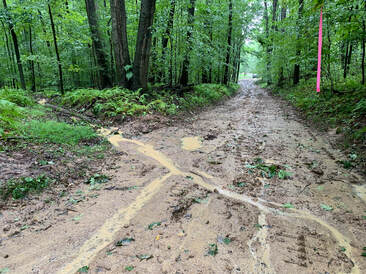Our Resource ConservationistOur Resource Conservationist administers the Chapter 102 Erosion and Sedimentation Pollution Control Program in Venango County. Duties include reviewing E&S plans, field inspections of earthmoving/disturbance sites, addressing environmental complaints, completing inspection reports, and providing technical assistance relating to voluntary compliance. Other duties involve administering National Pollutant Discharge Elimination System (NPDES) permits. For questions or to request technical assistance, please contact: Abigail Zerbe Resource Conservationist (814) 676-2832 ext. 3 [email protected] |
What is Erosion & Sediment Control? Sediment from this access road is seen entering a waterway. Erosion control measures should be in place at this location. Sediment from this access road is seen entering a waterway. Erosion control measures should be in place at this location.
PA Code, Title 25, Chapter 102 mandates that anyone engaged in "earth disturbance activities" must develop, implement, and maintain erosion control Best Management Practices (BMPs) to minimize the potential for accelerated erosion and sedimentation into Pennsylvania waterways. Locally, the VCD administers this program.
An earth disturbance activity is defined as: a construction or other human activity which disturbs the surface of the land, including, but not limited to, clearing and grubbing, grading, excavations, embankments, land development, agriculture tiling and plowing, timber harvesting activities, road maintenance activities, mineral extraction, and the moving, depositing, stockpiling or storing of soil, rock, or earth minerals. These activities, which expose bare earth to the forces of nature including wind and water, present the opportunity for accelerated erosion (that erosion that would not normally happen without human influence) and the possibility of sediment deposition into streams and other bodies of water. That deposition is referred to as sediment pollution, which can be very harmful to aquatic ecosystems. Sediment pollution (also an example of non-point source pollution) can be harmful because it can:
|
The goal of the program is to provide sufficient erosion control while the earth is exposed until such time that vegetation or some other impervious layer such as black-top can be re-established. Erosion control BMPs include items such as silt fence, hay bales, collection channels, sediment traps and basins, and ultimately permanent vegetation.
Erosion & Sediment Control Plans (E&S Plans)The specific details of your earthmoving activity determine the level of regulatory influence on a project. Erosion control BMPs are required for any earth disturbance regardless of size. Once the disturbed acreage reaches 5000sqft (about 70ft by 70ft) those BMPs have to be set forth in a written Erosion & Sediment Control Plan. E&S Plans must be designed based on specific criteria set forth in the E&S Pollution Control Program Manual and kept on the site during construction.
Once the disturbed area reaches one (1) acre, projects are required to obtain permit coverage under the National Pollutant Discharge Elimination System (NPDES) Program. National Pollutant Discharge Elimination System (NPDES) PermitsNPDES Permits are required for activities that disturb 1 or more acres. Since 2010, construction activities that proposed to disturb one or more acres of land have been required to obtain coverage under the National Pollutant Discharge Elimination System (NPDES) permit. The federally (EPA) mandated regulations aimed to better protect streams and other bodies of water from uncontrolled erosion and sediment pollution. In order to help local citizens better understand and comply with the regulations, the VCD agreed to administer the program a the county level (through the DEP).
Project requirements will still involve designing, implementing and maintaining an erosion & sediment (E&S) plan to minimize the potential of accelerated erosion & sedimentation. A separate aspect also requires the development of a Post Construction Stormwater Management Plan (PCSM). This plan must manage and treat stormwater leaving the site after construction is completed to protect water quality. Stormwater Best Management Practices (BMPs) should be used to maximize groundwater infiltration and protect the structural integrity of the receiving streams. Projects located in High Quality (HQ) or Exceptional Value (EV) watersheds must have the PCSM plan reviewed by the DEP Soils and Waterways Section in Meadville or adequacy. View our Watershed Management page to view HQ and EV watersheds. Farming operations, such as plowing and tilling, are exempt from permit requirements, provided they have a conservation plan developed and implement BMPs to reduce erosion. View our Agriculture page for more information. |
Important FormsClick the links below to access important forms
E&S Form & Fee Schedule Contains the application for an erosion & sediment pollution control plan review and associated fees E&S Plan Application Template This form is meant to be a guide for projects under 1 acre. More information may be needed. Timber Harvest E&S Plan Template This E&S Plan template only applies to timber harvest activities, as defined by 25 Pa. Code §102.1, which are not part of a larger development or conversion project. Notice of Termination (NOT) for Chapter 102 Permits Once requlatory requirements are met under your permit, the NOT form should be submitted to our district Notice of Termination (NOT) for Chapter 102 Permits - Instructions These instructions can be used to complete your NOT form |

